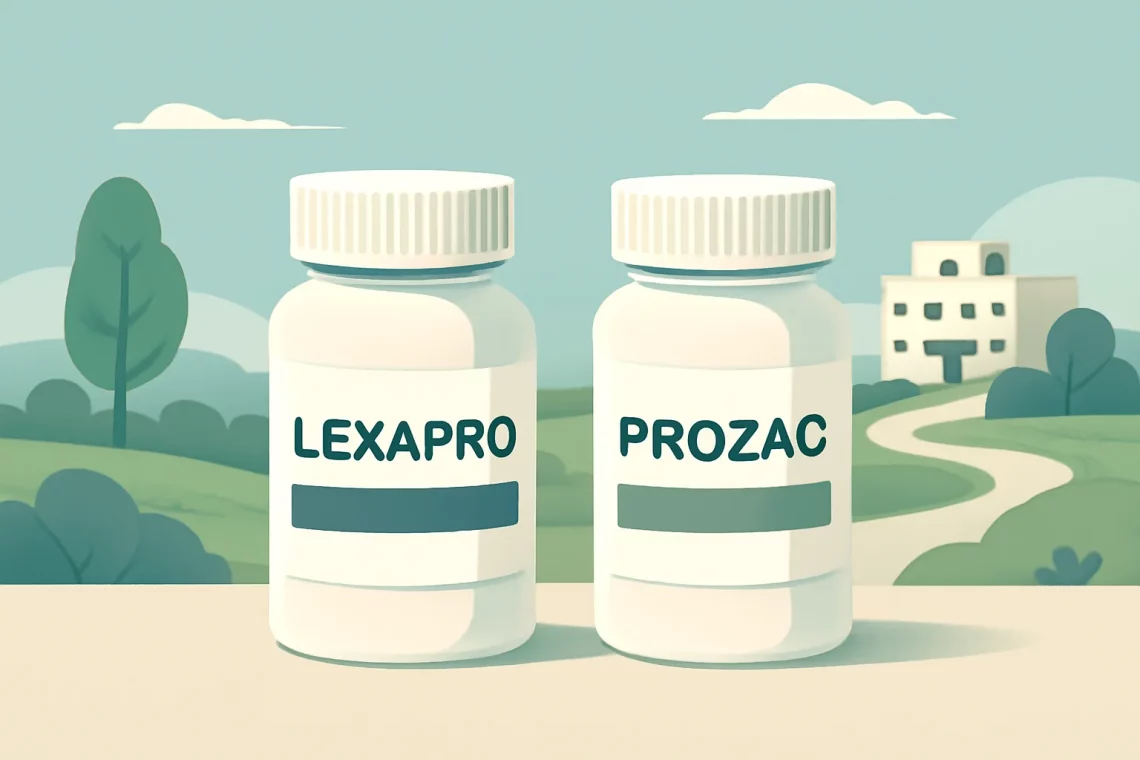
Lexapro vs Prozac: A Comprehensive Comparison of Two Antidepressants
Depression and anxiety are two of the most common mental health disorders affecting millions of individuals worldwide. As awareness of mental health issues has grown, so too has the range of treatment options available. Among these options, selective serotonin reuptake inhibitors (SSRIs) have gained prominence for their efficacy in treating depression and anxiety-related disorders. Lexapro and Prozac are two of the most well-known SSRIs prescribed by healthcare professionals.
While both medications aim to balance serotonin levels in the brain, their formulations and specific uses can vary significantly. Understanding the differences between Lexapro and Prozac is crucial for patients seeking effective treatment for mental health issues. Factors such as side effects, dosage, and interactions with other medications can influence a person’s choice of medication. As individuals seek the best pathways to mental wellness, comprehending these distinctions can empower them to engage in informed discussions with their healthcare providers.
In this article, we will explore the key features of Lexapro and Prozac, examining their uses, side effects, and how they work within the body to alleviate symptoms of depression and anxiety.
Understanding Lexapro
Lexapro, generically known as escitalopram, is an SSRI commonly prescribed for the treatment of major depressive disorder and generalized anxiety disorder. It functions by increasing the levels of serotonin, a neurotransmitter that plays a critical role in mood regulation. By inhibiting the reabsorption of serotonin in the brain, Lexapro helps enhance mood and reduce feelings of anxiety.
One of the primary advantages of Lexapro is its favorable side effect profile when compared to other antidepressants. Many patients report fewer side effects, which can include nausea, fatigue, and sexual dysfunction. These side effects can vary in intensity, and while some individuals may experience minimal discomfort, others may find them more pronounced.
Lexapro is typically recommended for adults and adolescents aged 12 and older. The initial dosage often starts at 10 mg per day, which may be adjusted based on the patient’s response and tolerance to the medication. It is imperative for patients to adhere strictly to their prescribed dosage and consult with their healthcare providers before making any changes.
Another key point to consider is the onset of action. Patients may notice some improvement in their symptoms within one to two weeks, but it may take several weeks to experience the full benefits of the medication. This delay can be frustrating for those seeking immediate relief, but it underscores the importance of patience and ongoing communication with healthcare professionals.
Lastly, it is essential to highlight that discontinuing Lexapro abruptly can lead to withdrawal symptoms, commonly referred to as discontinuation syndrome. These symptoms can include dizziness, irritability, and flu-like symptoms. Therefore, any changes in medication should always be done under a physician’s guidance.
Exploring Prozac
Prozac, known generically as fluoxetine, is another widely prescribed SSRI that has been available for several decades. Like Lexapro, Prozac is used to treat major depressive disorder and anxiety disorders. Additionally, it is often prescribed for conditions such as obsessive-compulsive disorder (OCD) and bulimia nervosa, making it a versatile option in the realm of psychiatric medications.
Prozac works by increasing serotonin levels in the brain, similarly to Lexapro. However, its pharmacological profile differs slightly, which can influence how patients respond. Prozac has a longer half-life, meaning it remains in the body for a more extended period. This characteristic can be beneficial, as it allows for more flexible dosing schedules and may reduce the risk of withdrawal symptoms when discontinuing the medication.
The typical starting dosage of Prozac is usually 20 mg per day, which can be adjusted based on individual needs. Patients may begin to notice improvements within the first few weeks, but full therapeutic effects might take longer to achieve, similar to Lexapro.
While Prozac is generally well-tolerated, it does come with its own set of potential side effects. These can include insomnia, gastrointestinal disturbances, and sexual dysfunction. As with any medication, the severity and occurrence of side effects can vary widely among individuals.
It’s also noteworthy that Prozac has been associated with a potential increased risk of suicidal thoughts or behaviors in younger populations. Therefore, close monitoring by healthcare providers is crucial, especially during the initial treatment phase or when dosage adjustments occur.
Overall, Prozac has a long-standing reputation and is often considered a first-line treatment for depression and anxiety, offering a broad spectrum of applications in mental health care.
Comparative Analysis: Lexapro vs Prozac
When comparing Lexapro and Prozac, several factors come into play, including their efficacy, side effect profiles, and specific indications. Both medications are effective SSRIs, but individual responses can vary significantly, making personalized treatment essential.
Efficacy is a crucial consideration. Studies have shown that both Lexapro and Prozac can be effective in alleviating symptoms of depression and anxiety. However, some patients may respond better to one medication over the other due to differences in their unique chemical compositions and how they interact with individual brain chemistry.
Side effects are another critical factor in this comparison. While both medications share common side effects, the intensity and frequency can differ. Lexapro is often associated with fewer gastrointestinal issues, while Prozac may lead to more pronounced insomnia. Patients must discuss these potential side effects with their doctors to weigh the benefits against any discomfort they may experience.
It is also essential to consider the specific conditions each medication is approved to treat. While both are effective for depression and generalized anxiety disorder, Prozac has additional indications for OCD and bulimia nervosa, which may make it a more suitable choice for patients with these specific conditions.
Lastly, the duration of treatment and the potential for withdrawal symptoms should be considered. Because Prozac has a longer half-life, it may be easier for patients to discontinue, as the gradual reduction of the medication can help mitigate withdrawal effects.
Ultimately, the choice between Lexapro and Prozac should be made in consultation with a healthcare provider, who can evaluate the individual patient’s history, symptoms, and preferences.
Making an Informed Choice
The decision to choose between Lexapro and Prozac can be daunting, especially for those new to antidepressant medications. It is essential for patients to engage in open dialogue with their healthcare providers, discussing their symptoms, medical history, and any previous experiences with medications.
Patients should also consider their lifestyle and how the medication may align with their daily routines. For example, if a patient has a busy schedule and requires a medication that allows for flexible dosing, the longer half-life of Prozac might be more appealing. Conversely, those who prioritize a potentially milder side effect profile may lean toward Lexapro.
In addition to discussing the medications themselves, patients should also inquire about the importance of therapy in conjunction with medication. Many studies have shown that combining medication with cognitive behavioral therapy (CBT) or other therapeutic interventions can enhance treatment outcomes and provide patients with valuable coping strategies.
Finally, it is vital for patients to monitor their progress and communicate any changes or concerns with their healthcare providers. Mental health treatment is often a journey that requires adjustments along the way. Maintaining an open line of communication will empower patients to make informed decisions about their treatment plans.
In conclusion, both Lexapro and Prozac are effective options for treating depression and anxiety, but individual responses may vary. By understanding the differences and working closely with healthcare professionals, patients can make informed choices that lead to improved mental health and well-being.
**Disclaimer:** This article is for informational purposes only and does not constitute medical advice. Always consult with a healthcare professional for any health-related concerns or before starting or stopping any medication.




